15 MIN READ
Effects of Weather and Disease on Commercial Soybean Seed
August 6, 2019
In any one year, yield potential can be reduced by several soybean diseases that can infect the crop depending on product susceptibility, available source of infection (fungus, bacterium, virus), timing of infection, and environmental conditions. However, only a few diseases have the potential to affect soybean seed quality and germination.
In general, the most probable conditions and time for quality deterioration of soybean seed by bacterial and fungal diseases occurs when the environment is warm and wet near or after seed maturation (Figure 1). A timely harvest after maturation is the best management practice for reducing the potential impact of these types of diseases on seed quality. Reductions in seed quality from viral diseases are not as dependent on temperature and moisture conditions.
Purple seed stain, caused by Cercospora, and the complex of Diaporthe fungal diseases (Phomopsis seed decay and pod and stem blight) are the diseases most mentioned for causing reductions in germination, and oil and flour quality. Frogeye leaf spot, Anthracnose, and downy mildew can also reduce seed quality but generally less so than purple seed stain and the Diaporthe complex of diseases. Additionally, diseases caused by Alternaria, Fusarium, Cladosporium, and Penicillium are known as secondary diseases responsible for quality reduction because they have the potential to infect plants after injuries from insects, hail, or mechanical means.
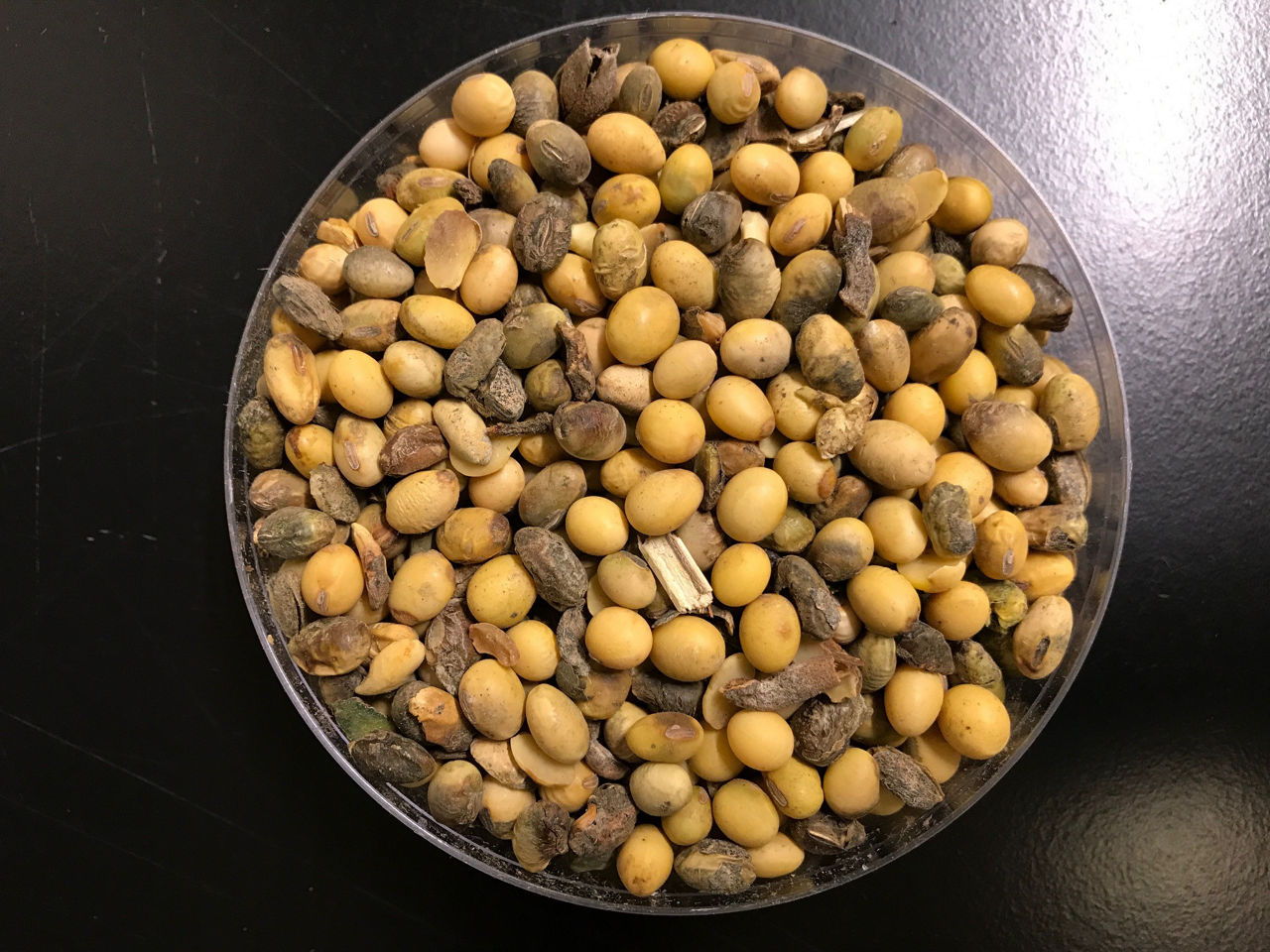
Soybean Diseases Most Likely to Cause Reductions in Germination and Seed Quality
Purple Seed Stain
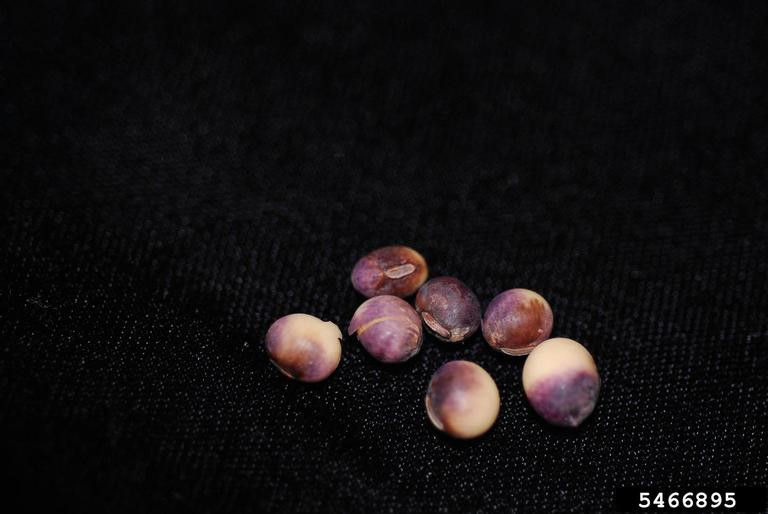
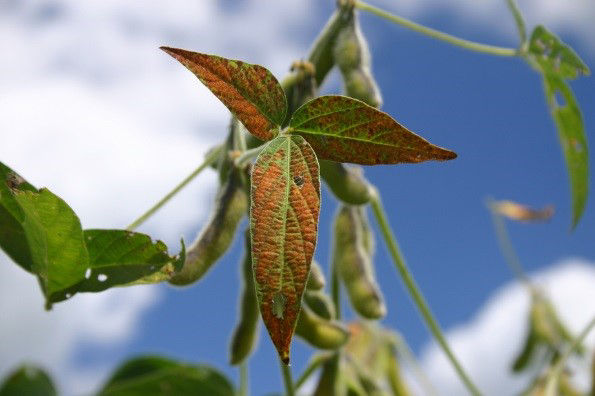
Identification, Characteristics, and Diagnosis:
Caused by the fungus Cercospora kikuchii.
Infected pods are likely to be purplish.
Infected seeds can be partially or entirely “stained” purple (Figure 2).
Initial foliar symptoms include light- to dark-purple areas on sun-exposed leaves that eventually become leathery, dark, reddish-purple, bronzed, and/or blighted (Figure 3).
Management:
Apply Delaro® 325 SC Fungicide. To learn more about applying Delaro® 325 SC Fungicide, please visit https://www.cropscience.bayer.us/products/fungicides/delaro and contact your retailer.
Earlier-maturing soybean products may not be infected.
Individual soybean products may have higher tolerance levels.
Rotate to non-host crops.
Residue management through tillage can help reduce pathogen survivability.
Diaporthe Diseases (Phomopsis Seed Decay and Pod and Stem Blight)
Phomopsis Seed Decay
Identification, Characteristics, and Diagnosis:
Caused by the fungus Diaporthe longicolla.
Infected seed can be shriveled, undersized, and have a white or chalky appearance (Figure 4).
The interior of pods can contain a white, cottony mold.
Favored at warm, wet weather during pod fill.
Early-maturing soybean products may be more prone to infection.
Moisture content levels below 19% retard infection.
Management:
Do not plant infected seed.
Seed treatments may help improve emergence.
Plant resistant soybean products.
Select fuller-season (for the area to be grown) soybean products.
Utilize tillage to help promote residue deterioration.
Control weedy hosts such as velvetleaf.
Harvest in a timely manner to reduce the risk of extended exposure of the mature crop to wet weather.
Pod and Stem Blight
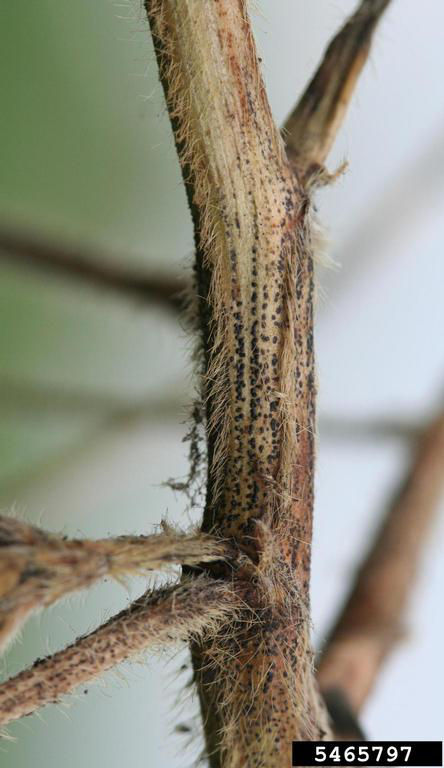
Identification, Characteristics, and Diagnosis:
Caused by various species of the fungi Diaporthe and Phomopsis. Diaporthe sojae is the preferred scientific name.
Pathogens overwinter on infected seed and soybean residue.
Linear rows of dark specks (fungal fruiting bodies) develop on stem nodes, pods, and petioles (Figure 5).
The upper plant canopy turns yellow and dies.
Pod infection can occur at flowering; however, most are infected around the R7 growth stage (beginning pod maturity). Injury to pods by insects favors pod infection.
Seeds may appear healthy, shriveled, cracked, or chalky because of coverage by white mycelium.
Oil and flour quality can be reduced.
Favored by wet weather during maturation growth stages and delayed harvest.
Management:
Rotate crops to help reduce the amount of infected residue.
Utilize tillage to promote decay of infected residue.
Harvest in a timely manner to reduce the risk of extended exposure of the mature crop to wet weather.
Utilize seed treatments to protect seed.
- Apply Delaro® 325 SC Fungicide. To learn more about Delaro® 325 SC Fungicide, please visit https://www.cropscience.bayer.us/products/fungicides/delaro and contact your retailer.
Other diseases that can reduce germination and seed quality
Anthracnose

Identification, Characteristics, and Diagnosis:
Caused by the fungus Colletotrichum truncatum.
Brown to black, irregularly-shaped lesions on stem, pods, and petioles.
Premature defoliation can occur from petiole girdling.
Infected pods may be filled with mycelium instead of seeds, or seeds may be fewer and/or smaller and can also be brown, moldy, shriveled, or normal in appearance.
Dark spines or setae stick out from the acervuli (fruiting bodies) within lesions (Figure 6).
Leaves roll and exhibit necrosis of minor veins between the major veins.
Favored by warm, wet, humid conditions.
Downy Mildew

Identification, Characteristics, and Diagnosis:
Caused by a fungus-like organism, Peronospora manshurica.
Overwinters in the soil and in infested crop debris.
Infection occurs in the spring when oospores germinate and infect seedlings.
Upper surfaces of young leaves develop pale-green to light-yellow spots which enlarge into pale- to bright-yellow lesions (Figure 7).
White to gray fungal tufts develop on the underside of the lesion.
Oldest lesions become grayish-brown to dark-brown with yellowish-green margins.
Masses of fungal-like growth can develop in pods and cause seed to become dull white and covered with the pathogen.
Favored by high humidity levels.
Management:
Plant resistant soybean products.
Rotate with a non-host crop for one year or more.
Rarely affects yield; therefore, foliar fungicides are not recommended.
Manage residues.
Seed treatments can help protect seedlings from initial infection.
Frogeye Leaf Spot
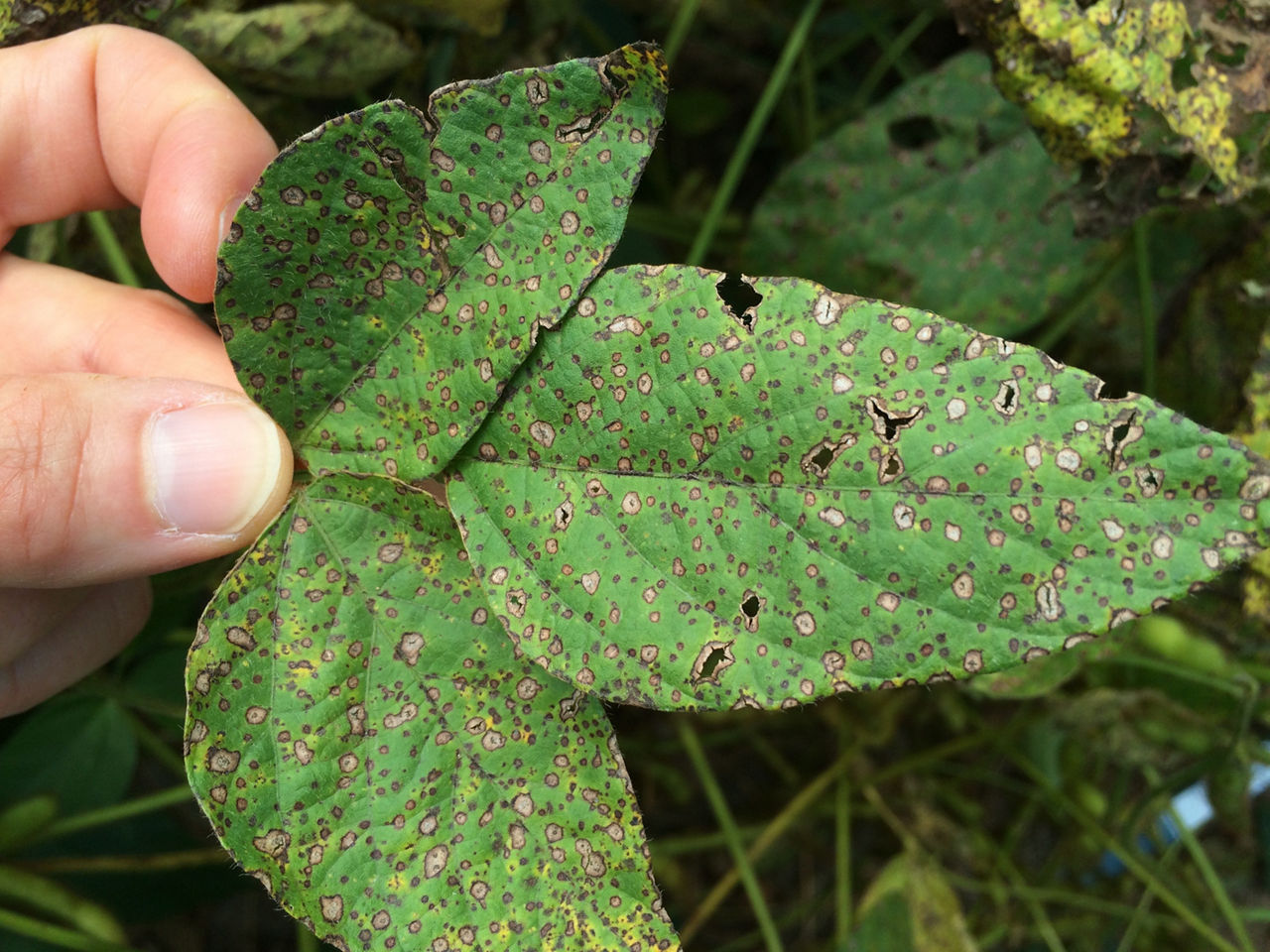
Identification, Characteristics, and Diagnosis:
Caused by the fungus Cercospora sojina.
Symptoms initially appear during reproductive growth stages as dark, water-soaked lesions on younger leaves with centers that become ash-gray to light-brown in color.
Later, the lesions become circular to angular with a purple to dark-brown margin around the tan to gray center (Figure 8).
On leaf undersides, the center of the lesions may have a dark-black area where spores are being produced.
Favored by warm (77 to 86°F) temperatures and prolonged periods of dew or light rain.
Lesions can grow through pods and may cause seeds to be dark, shriveled, and have cracked seed coats. Seeds can also have no symptoms.
Management:
Plant resistant soybean products.
Crop rotation and tillage to encourage residue decomposition can help reduce pathogen levels.
- Apply Delaro® 325 SC Fungicide. To learn more about Delaro® 325 SC Fungicide, please visit https://www.cropscience.bayer.us/products/fungicides/delaro and contact your retailer.
Alternaria Leaf Spot
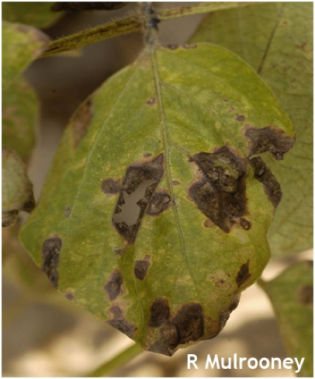
Identification, Characteristics, and Diagnosis:
Caused by fungal species of Alternaria, a seedborne pathogen.
Leaves may become reddish or yellowish in color.
Dark-brown lesions, usually with concentric rings, ¼ to 1 inch in diameter usually appear on leaves and pods near soybean maturity throughout the canopy (Figure 9).
Leaf lesions enlarge and merge together to produce large dead areas.
Leaves eventually die and fall from the plant.
Infected seeds are smaller, shriveled, and dark-brown to black.
Favored by warm, moist conditions late in the growing season.
Usually a secondary disease after mechanical or insect injury, or another disease.
Management:
Infection usually occurs very late; therefore, management is generally not necessary.
Many soybean products have resistance.
Seed treatments may offer protection.
Apply Delaro® 325 SC Fungicide. To learn more about Delaro® 325 SC Fungicide, please visit https://www.cropscience.bayer.us/products/fungicides/delaro and contact your retailer.
Bean Pod Mottle Virus (BPMV)
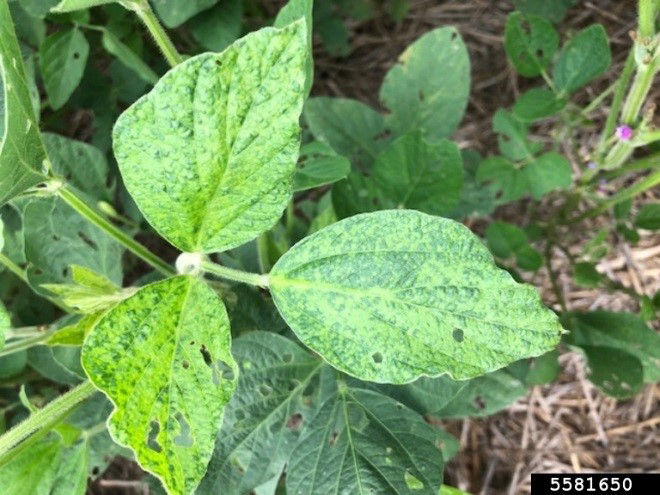
Identification, Characteristics, and Diagnosis:
Vectored by the bean leaf beetle, Cerotoma trifurcate Förster.
Foliar symptoms range from mild chlorotic mottling on upper leaves to puckering and severe mosaic in lower leaves (Figure 10).
Delayed maturity or green stems are often observed near harvest.
Seed coat mottling may be present.
Virus overwinters in bean leaf beetles and can infect seedlings as the beetles feed.
The virus can also overwinter in perennial weeds and infected seed.
Plant infection by BPMV and soybean mosaic virus (SMV), vectored by soybean aphid, may cause severe dwarfing, foliar distortion, leaf necrosis, leaf mottling, and severe yield loss.
Management:
Managing emerging and first-generation bean leaf beetles in the spring with timely and labeled insecticides can reduce populations of the virus-laden insects.
Controlling alternative BPMV hosts (cowpea (Vigna unguiculate), other bean species, and Demodium species) can help reduce the inoculum source.
Delayed planting may increase early-season death of bean leaf beetles, reducing the vectoring population.
Soybean Mosaic Virus (SMV)
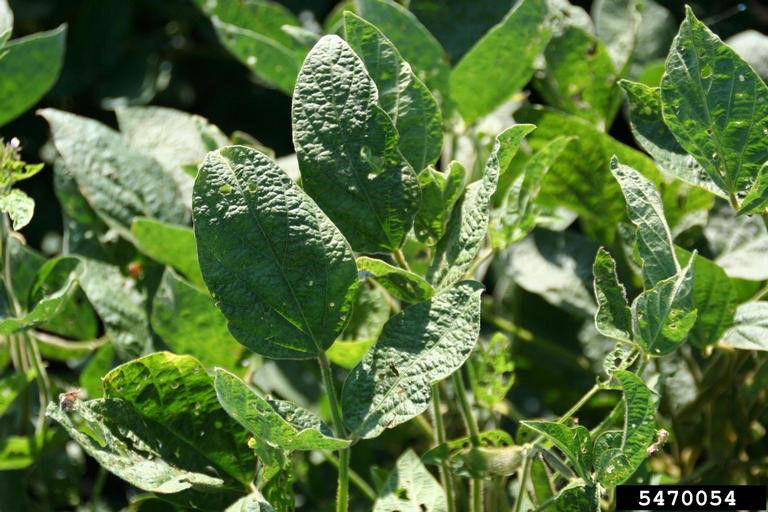
Identification, Characteristics, and Diagnosis:
Aphids are a primary vector.
A green/yellow mosaic pattern is the most common initial symptom on leaves (Figure 11).
More mature leaves may exhibit a yellow/brown mosaic pattern.
Premature defoliation is common.
Infected seeds exhibit a brown or black mottling.
Spread from plant to plant by soybean aphid feeding.
Plant infection by SMV and bean pod mottle virus (BPMV), vectored by bean leaf beetle, may cause severe dwarfing, foliar distortion, leaf necrosis, leaf mottling, and yield loss.
Management:
Seeds should be virus-free.
Plant resistant soybean products.
Early planting may minimize aphid transmission at an early crop growth stage.
Insecticide applications are not recommended because some insecticides may increase soybean aphid movement in the field, increasing the dissemination of the virus.
Aspergillus, a fungus that can infect seed in storage, can reduce seed viability.
Cladosporium is a seedborne pathogen; however, infections are rare.
Fusarium seed infection is likely related to an early-season infection.
Sources
Telenko, D. 2018. Fungal diseases that can impact soybean pod and seed quality. Pest & Crop Newsletter. Purdue University. https://extension.entm.purdue.edu/.
Bradley, C.A. 2018. Phomopsis seed decay and purple seed stain prevalent in harvested soybeans. KyGrains.info. University of Kentucky. https://www.kygrains.info/blog/.
Mueller, D., Bradley, C., Chilvers, M., Giesler, L., Mathew, F., Smith, D., Tenuta, A., and Wise, K. 2015. Pod and stem blight and Phomopsis seed decay. Soybean Disease Management. CPN-1007. Crop Protection Network.
Hershman, D.E. 2012. Downy mildew of soybeans. Plant Pathology Fact Sheet. PPFS-AG-S-03. University of Kentucky.
Westphal, A., Abney, T.S., and Shaner, G. Frogeye leaf spot. Diseases of Soybean. BP-131-W. Purdue University Department of Botany and Plant Pathology and USDA-ARS. Purdue University. https://www.extension.purdue.edu/.
Giesler, L.J. Pod and stem blight. CROPWATCH. University of Nebraska. https://cropwatch.unl.edu/.
Sources verified 7/17/19.
6003_S2